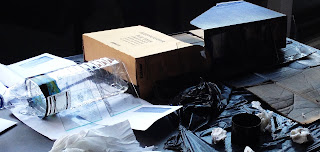December 12, 2012
Unit Summary
Week Eleven: Time & the Image: Final Outcome
Week Eleven: Time & the Image: Potential Final Images
Week Ten: Time & the Image: Creating Final Outcome
Week Ten: Time & the Image (Research): Eadweard Muybridge
December 09, 2012
Time & the Image: Experimentation: Part 2: Water
Time & the Image: Experimentation: Part 1: Old Objects
December 03, 2012
Week Ten: Time & the Image (Research)
Week Ten: Time & the Image: Brainstorm
Potential Ideas
Capturing Movement:- Long Exposures
- Photographing decay, erosion, fading of something over time
- Freeze framing water
- Changing of the sky through day and night
Week Nine: Narrative: Donnie Darko "The Mad World Scene"
- Panorama shot connecting all the characters reacting and waking up from a dream
- The song 'Mad World' (Gary Jules) is played over the scene and additional sound is removed, the lyrics and somber mood of the song narrate it in a more emotional way than perhaps dialogue could.
- Body language of characters is important because of the lack of dialogue
- Girl and mother are filmed in a way that it could be freeze framed like a photograph
- Flashbacks: multiple images in a grid representing crazed disorganised thoughts
November 28, 2012
Week Nine: Image Processes: Exhibition
November 25, 2012
November 22, 2012
Exhibition Visit
Tim Walker 'Story Teller'
Somerset House, London
Somerset House WebsiteTim Walker Official Website
Exhibition Visit
Jochem Hendricks
John Hansard Gallery, Southampton
Week Seven: Digital Workshop: Visual Histories Exhibition
Week Six: Digital Workshop: Final Outcome
Week Six: Digital Workshop (Photoshop)
Week Five: Pinhole & Wet Collodion Exhibition
Week Four: Digital Workshop (Photo Studios)
Light Meter
Bibliography
Candida Höfer
Extract: "Whether the aura of absence is signalled by the physical dominance of white, the exclusion of man's physical presence, or references to the social activity- without personalisation- that would be consonant with the classification of the interior, Höfer leaves us with uniquely evocative spaces that are not empty. They are devoid of any diversions that would disrupt her transcendental rooms- where nothing is staged, but where, as the architect of order, Höfer leaves nothing to chance."
2)
Andreas Gursky
The Museum of Modern Art (New York)
Author: Peter Galassi
Publisher: MOMA: Thames & Hudson
3)
Eadweard Muybridge 55
Author: Paul Hill
Publisher: Phaidon
Extract: "Eadweard Muybridge (1830-1904) is a key name in early photographic history. His pioneering locomotion studies of the 1870s + 1880s which produced over 20,000 photographs, radically changed the way in which people understood animal and human movement."
4)
Mouthpiece
Justin Quinnell
Publisher: Dewi Lewis Publishing
Extract: "The earliest reference to pinhole was in 5 century BC when the Chinese philosopher Mo-Ti compared light forming an image through a hole to 'an arrow being fired'."
"My own journey started in the early 1990s. Many of my students couldn't afford cameras, but could afford several cans of fizz a day."
5)
Photographs 1978-2004
Jeff Wall
Written by: Sheena Wagstaff
Publisher: Tate Publishing
Extract: "Weaving together the narrative and compositional potential of all three media to create a sympathitc celebration of quotidian life, Wall also spins subtle enigmas within his scenarios, which- if we are prepared to look closely- sharpen our awareness about their subjects without ever leading us to conclude a 'moral to the story'."
6)
The Genius of Photography
How Photography Has Changed Our Lives
By: Gerry Badger
Gregory Crewdson
Work: Ophelia - Digital (Type C) Coloue Print, from series: Twilight
Extract: "Here Crewdson's protagonist floats in her flooded living room, dressed in her lingerie. Her eyes are open, and her slippers are on the stairs above the flood. She may be dead, but there is a ecstatic look on her face and she is floating above the water rather than in it."
(Book also contains the work of Rineka Dijkstra)
































